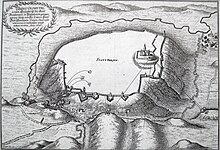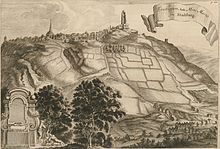Eresburg
| Eresburg | |
|---|---|
| Obermarsberg | |
| Coordinates | 51°27′01″N8°51′10″E/ 51.45028°N 8.85278°E |
| Type | hill castle |
| Code | DE-NW |
| Height | 390 m abovesea level (NHN) |
| Site information | |
| Condition | Rampart remains |
| Site history | |
| Built | before 772 |
TheEresburgis the largest, well-known(Old) Saxonrefuge castle(Volksburg) and was located in the area of the present German village ofObermarsbergin the borough ofMarsbergin the county ofHochsauerlandkreis.It was ahill castlebuilt on the plateau of a lowtable hill,known as theEresberg,at a height of 130–150 metres above theDiemel,a tributary of theWeser,in the extreme south of the SaxonGauofEngernon the border with theDuchy of Franconia.
History
[edit]

There is evidence that indicates the hill was settled even in prehistoric times. Pieces of pottery from theMichelsberg culturehave also been found here. Excavations in the vicinity of the present-daycollegiate churchhave revealed traces of ditches, ramparts and posts.Radio carbon datingpoints to their origin in the pre-RomanIron Age.In addition the wooden posts were made from trees that can be dated to between 420 and 370 B.C.[1][2]
Earlier research viewed the Eresburg as a border castle of theCheruscitribe and a fortress of PrinceSegestes,who was supposed to have held his daughter,Thusnelda,prisoner here.[3]However, there are no records supporting that theory.
Thanks to its favourable position on the border, the castle was repeatedly attacked and hard fought for before being conquered in 772 A.D. during theSaxon Warsby theFrankish king,Charlemagne.Charlemagne had theIrminsul,a pagan religious site here or in the vicinity, destroyed. In 779, he charged theFuldaabbot,Sturmius,withmission servicein this area and directed him to this location. As early as 784/785 Charlemagne overwintered at Eresburg and had a church built, probably on the site of the former Saxon temple.PopeLeo IIIis supposed to have stayed at the Eresburg in 799 on his way toPaderborn.In 915 there was a bloodyfeudat the Eresburg between theSaxonDukeHenry the Fowlerand theEast Francianking,Conrad.The Bishop of Paderborn,Theodericis also supposed to have participated personally in the battle. Also in 915 at Eresburg the invading Hungarians defeated a German army.[4]
Eresburg as site of the Irminsul
[edit]Eresburg may have been the site of theIrminsul,a sort of pillar or tree, and one of the chief pagan religious sites of theSaxons.The wording of theRoyal Frankish Annalsin 772 suggests that the Irminsul might have been located either at the Eresburg itself or in the near vicinity. TheAnnales Petavianistates:"He conquered the Eresburg and found the place which is called Ermensul, and set these places on fire."On the one hand, therefore, Charlemagne captured the Eresburg and, on the other,"pervenit ad locum, qui dicitur Ermensul",i. e. he found the site that was called Irminsul. The writer calls the site of the Eresburg,Erisburgo,i.e. notErmensula.The third part of the sentence runs"et succendit ea loca",i. e. he set "these places" (plural) on fire,[5]possibly implying that Charlemagne moved on from the Eresburg to the Irminsul.
According to other sources, Charlemagne stayed near the Bullerborn,[6]an intermittent spring nearAltenbeken,before he conquered and destroyed the Irminsul site in the days that followed.
The question over the location of the Irminsul is however, probably, misleading; because there may have been several of them.
References
[edit]- ^"Hermann Runte: Zur Geschichte Marsbergs. Sauerland. Heft 2, 2010".Archived fromthe originalon 2013-10-27.Retrieved2014-05-23.
- ^Daniel Bérenger: Die eisenzeitliche Höhenbefestigung von ObermarsbergdigitalisedArchived2013-10-29 at theWayback Machine(pdf; 552 kB)
- ^Johann Suibert Seibertz: Landes- und Rechtsgeschichte des Herzogtums Westfalen. Vol.1, Arnsberg, 1860, p.15
- ^Baják László: A fejedelmek kora. A korai magyar történet időrendi vázlata. II. rész. 900-1000( "The Era of the Princes. The chronological sketch of the early Hungarian history. II. part. 900-1000" );ÓMT, Budapest, 2000 p. 14
- ^W. E. Giefers:Eresburg, Irminsäule, Bullerborn.1878, p. 143f.
- ^The"u"has become"o",todayBollerbornspring
Literature
[edit]- Gerhard Mildenberger, Fred Schwind, Jürgen Udolph:Eresburg.In theLexicon of Germanic Antiquity Studies(Reallexikon der Germanischen Altertumskunde) (RGA). 2nd edition, Vol. 7, Walter de Gruyter, Berlin/New York 1989, p(p). 475–482. (introductory specialist article)
- Daniel Bérenger:Die eisenzeitliche Höhenbefestigung von Obermarsberg.In:Archäologie in Ostwestfalen6. Verlag für Regionalgeschichte, Bielefeld 2002, pp. 29–33, (online (pdf, 552 kB)Archived2013-10-29 at theWayback Machine).

